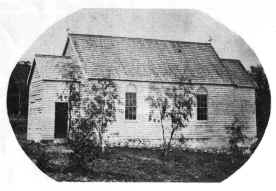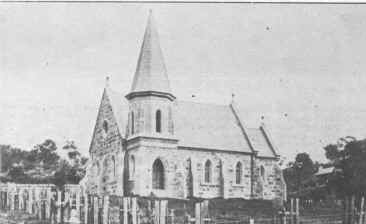
Home | Pioneers | Contact Us | Copyright/Disclaimer
The Anglican Church at Adaminaby
From the History of the Diocese of Goulburn, Ransome T Wyatt, 1937, p189-192
In the early days of settlement Adaminaby was known as Seymour. The present parish of Adaminaby is of comparatively recent formation. It was constituted on the 6/11/1911 but ministrations in the area date back long before that. Its early history must be read in the itinerating ministries of the Rev. E. Smith (Queanbeyan, 1838), the Rev. W. G. Nott Maneroo 1842), the Rev. E. G. Pryce (Maneroo, 1843), the Ven. Archdeacon Druitt (Cooma, 1856), and in the history of the parish successively known as Gegedzerick, West Manaro and Berridale from 1876 to 1911 One
of the earliest references to such ministrations is in the Sydney Church Society's report for 1860 where it is recorded:
"The Church Society's committee has also been called upon to pay the stipend of the clergyman employed at the Kiandra goldfield. Two of the resident storekeepers promised that half the stipend should be forthcoming from the district, and the committee entrusted with the management of the Gold Field Mission Account would have supplied the other moiety of the salary. The promised aid was not forthcoming from the district and the Church Society having paid the stipend for three months, the clergyman was withdrawn."
In 1862 a Bible and Prayer Book were given by the diocesan committee for services at Adaminaby, and in 1863 the Sunday School received a grant of books.
On the 12th November, 1862, the foundation stone of the first Church of St. John the Evangelist, at Adaminaby, was laid by Mrs. Mould, and the Church was opened for Divine Worship on the 14th June, 1863:-
"The Rev. Thomas Druitt, Pastor; Messrs. George Yonge Mould, Thomas Locker, George Barrett, and Archibald Reynolds, trustees."
 St. John's Adaminaby
St. John's Adaminaby
Detailed accounts are extant of the cost of this building, e.g., 1,000 ft. boards £12/10/-; 500 ft. battens, £5/10/0; 900 ft of weatherboards, £11/5/-; 500 ft. joists, £5; 1,400 laths, £4/4/-; 3,200 shingles, £4/16/-. The whole building and its furnishings cost £263/8/2.
In May, 1863, the Rev. E. Synge visited Kiandra. Snow had fallen and he had a difficulty in reaching it. The settlement had dwindled to 300 "European inhabitants and a somewhat larger number of Chinese." Kiandra, which previously had a much larger population, was being visited once a quarter by the rector of Cooma. Synge held a service in the hotel for a small but attentive congregation. Two persons were arrested and lodged in the lock-up whilst Synge was there, on the suspicion of being in league with bushrangers. (Church of England Chronicle, 21/7/1864, P.108)
In 1866 the Rev. T. Druitt was visiting Adaminaby once a month. Tenders were called for a six-roomed stone house for the school-master. The hope was expressed that the new school master would begin a Sunday School and "if he is a man of sufficient zeal and discretion perhaps we may have regular Sunday services celebrated when the Rev. T. Druitt is not here." (Church of England Chronicle, 8/8/1866, P. 258)
There are, of course, numerous references to Adaminaby in the Cooma and Gegedzerick registers. Its first mention in diocesan records is in 1869 when it is credited with (£1/4/-, a collection "after sermon by the Rev. T. Druitt."
The parochial cash book for 1862 to 1868 is extant and records £271/11/11 raised in all for Church purposes, of which £263/8/2 was expended on the Church, £1/2/6 to the "Conference Fund,"£1/15/6 to the Cooma parsonage fund, £1/5/6 to the Synod fund, and strangest of all £2/11/9 to the "Fund for rebuilding Gunning Church."
From 1862 to 1876 the churchwardens' accounts make no reference to stipend payments. The "offertory collections" all went in Church expenses and diocesan dues. The diocesan dues, however, include contributions to the Church Society out of which the stipend of the rector of Cooma was paid.
The first list of Churches in the diocese was published in 1872 and Adaminaby is shown there as possessing a wooden Church. The first confirmation in Adaminaby is there said to have been held on 28/1/1872. This, however, is a mistake. The wardens' accounts show one on 5/5/1864. The first list of contributions by the Adaminaby centre to the Cooma stipend published in the Church Society reports is for the year 1872. There are 40 names and the total contributions are £49/14/6. The Rev. J. H. Williams, curate to Archdeacon Druitt, was working in this area and Jegedzerick particularly. In 1876 Jegedzerick (with Adaminaby) was cut off from Cooma and Adaminaby formed part of the West Monaro charge until 1911. Adaminaby's contribution for stipend in 1877 was £19/16/7 By 1879 it has grown to £82/10/-. In 1883 it amounted to £150/14/5 but a footnote states this is for five quarters. Contributions to the Gegedzerick parsonage and its repair are frequent. In 1887 the old harmonium was sold for £2/12/6 and a new one bought for £20/13/6. Receipts seem to have fallen off again with the hard times of the early nineties, but later Adaminaby grew steadily in importance and in its returns until 1906, when the parish of West Monaro engaged its first curate. From 1906-1911 Adaminaby occupied more and more of the attention of the assistant, who was often resident there in quasi-sole charge. Such were F. A. Woodger, 1906-7 (the present Church was built by the Rev. B. D., afterwards Archdeacon, Bryant, in 1906-7), E. E. Edwards 1907, both subdeacons, E. W. Julien 1907-8, and A. G Rix 1908-9, both lay readers, L. A. Kelynack 1909 - 1910 a deacon, and J. C. Ashworth 1910 - 11 a priest. In 1911 it was severed from Gegedzerick and, the Rev. W. Parkes placed in charge. Adaminaby's progress since then has been steady. Mr. Parkes was there for two years; the Rev. J. M. Thomas for four. The Rev. H. J. Gedney stayed for five years and did much good work. Another longer incumbency was that of the Rev. H. S. Brown, who was rector for nine years. In his time the present rectory was purchased. The Rev. R. B. Dransfield was rector for two years, and the Rev. G. E. Martin since 1935.
St. JOHN'S CHURCH, ADAMINABY.
The foundation stone of the first Church was laid by Mrs. Mould on 12/11/1862. The Church was opened on the 14/6/1863. The minute book records "The Rev. Thomas Druitt, pastor." This Church still stands and is used as a Sunday School. It is of wood and now has an iron roof.

The present S. John's Church is a stone building with a roof of cement tiles and a small tower and spire. It was built during the late Archdeacon Bryant's term as rector of West Monaro. The foundation stone was laid on 30/11/1906 by Bishop Barlow. It was licensed on the 11/12/1907, dedicated on 15/12/1907 by Archdeacon Bartlett, and consecrated on 12/3/1909. The bell was dedicated on 19/1/1908 The stone font is inscribed "the Gift of the Children," a prayer desk and lectern are to the memory of Private Elliott Hyles, and two flags are in memory of Private Albert Tozer. Two stained glass windows, subjects "Hope" and "S. John the Divine," commemorate Mary Mackay and John Mackay, respectively. Another window, subject "I stand at the door and knock," is in memory of George Mackay. There is an oak honour roll of fallen soldiers. A window (subject S. George M.) near the honour roll, and a brass plate, commemorate G. Larkin, A. Tozer, E. Hyles, J. Gilbert, W. Pryce, B. Harris, E. Turner, 0. Hyles and A. Hetherington, all fallen soldiers.
The altar is in memory of the late George and Catherine Mould and was given by their children. Two brass vases commemorate the late Mortimer James Watson. The litany desk is in memory of the late Mrs. Chas. Locker. A small stand used as a pulpit was given by the parishioners in memory of the late Evan E. Edwards, catechist. St. John's had a brass alms dish but a second one was given by the widow of the late Rev. Samuel Hart, rector of West Monaro, in memory of her husband. A small book rest for the altar was given by the Sunday School teachers. The gate in the communion rail is in memory of Amy Esma Oldfield. A sanctuary chair was given in 1920 by Mrs. Welch as a thank-offering for the safe return of her two sons from the war. A marble tablet to the memory of the late Archdeacon Druitt was removed from the old Church to the new in 1911. The altar cross was the gift of Archdeacon Bryant. The architect of the building was Mr. G. D. Cochran, of Cooma, and the contractor Mr. A. Mawson, of Cooma. Archdeacon Bryant designed the furniture.
St. THOMAS' CHURCH, MIDDLINGBANK.
A wooden Church was built at Rocky Plain in 1890. In 1900 it was removed and transferred from Rocky Plain to Middlingbank, and became St. Thomas' Church, Middlingbank. The parishioners jointly subscribed after the war for the following memorials in memory of fallen soldiers: A brass cross and two altar vases in memory of the late William L. Pryce, a prayer desk and lectern in memory of Private Elliott Hyles, and a stone font in memory of Private Oscar Hyles. The Church was repaired and painted externally in 1935. The holdings are large and the population scattered, but the Church is usually well attended.
THE CHURCH OF THE ASCENSION, KIANDRA.
The Church which is often humorously described as the "highest Church in the diocese" (height above sea level 5,000 feet). It was built in 1922, licensed on 28/2/1924 and dedicated 18/3/1924. Services in this centre were begun at a very early date, 1860 if not before.
On two previous occasions a building for Church services was erected at Kiandra only to be used later as a wood shed or a goat house, and finally burned for firewood. About 1902 a movement was begun to build a Union Church here, but nothing came of it. In 1922 the trustees of the Union Church gave the funds in hand, £8, to the building of the Church of the Ascension, the first dedicated place of worship built in Kiandra.
Some years previously an English lady gave £70 to the Colonial and Continental Church Society towards the building of a Church at Kiandra. Later, hearing of the gift and the apathy of the Kiandra people, the Dalgety people got the permission of the donor to divert the gift to Dalgety if the Kiandra people did not want it. That moved the Rev. H. J. Gedney and he had the money reallotted to Kiandra. With this as a start he collected sufficient funds to build the present Church. The plan is similar to that of the Westbrook Church, in the Tarcutta parish, with the addition of a small sanctuary. The building is of weatherboard on a stone foundation. Dimensions, 25ft. x 15ft., with porch 6 1/2 ft. and sanctuary 9ft. square. The first service was held on Friday, 12th May, 1922.
THE PARISH HALL.
Is the old wooden Church, now seventy-five years old.
THE RECTORY.
The rectory, a small brick building with an iron roof, was purchased in 1928. It is not altogether suitable and will soon have to give way to something better.
ENDOWMENT.
There is the nucleus of a parochial endowment, viz., _f 200 given by S. Mackay, and 25 by J. Widdowson.
LIST OF RECTORS.
Parkes, W. A/Rector ..... 1911-1913
Thomas, J. M . ........... 1913-1917
Gedney, H. j . ............ 1917-1922
Brown, H. S . ............. 1922-1931
Dransfield, R. B . ........ 1932-1934
Martin, G. E ............... 1935
From the History of the Diocese of Goulburn, Ransome T Wyatt, 1937 p189-192, transcribed by Pattrick Mould 2003
|